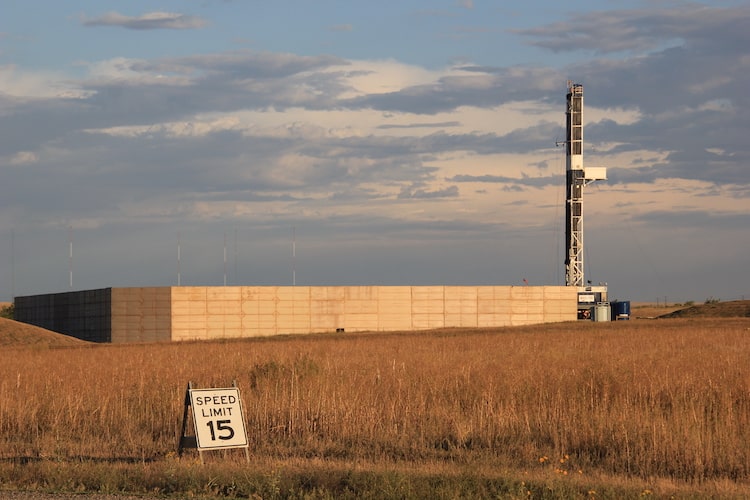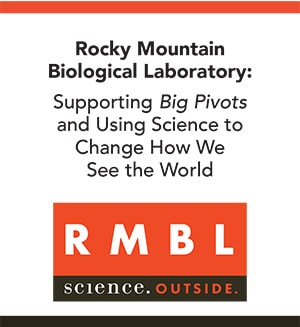Industry association tries to navigate path forward amid tightening scrutiny
by Allen Best
Like many other conferences, the annual Energy Summit sponsored by the Colorado Oil and Gas Association has downsized during the last two years. The event was cancelled last year and this year was held at the Denver Museum of Nature and Science. That venue, if nicely appointed, is almost diminutive in comparison with the cavernous Colorado Convention Center where I attended 8 to 10 of the industry group’s gatherings through the years.
Moreover, conference attendees this year had the choice of attending in person or monitoring the presentations by video.
The result was fewer than a hundred or so people in attendance at the one session I attended in person, compared to perhaps a thousand or more at the prior conferences along with an adjacent room full of vendors hawking their services and technologies.
Was this downsizing purely a reflection of the uncertainty and still-potent threat posed by covid and perhaps an effort to trim some extravagances? Or was it, I wonder, reflective of an industry’s decline? Fifteen years ago, coal producers were fat and sassy. Now even the major companies are fleeing. Can this sector tack a different course?
Production remains strong, as evident in the drilling now underway from the outskirts of metropolitan Denver north and east. This last week, Will Toor, executive director of the Colorado Energy Office, in his presentation to the Air Quality Control Commission, noted that the Greenhouse Gas Pollution Reduction Roadmap that was issued in January, projects production actually increasing through 2030.
In Colorado, the oil and gas industry remains a powerful sector, but less so than in Wyoming and New Mexico. Colorado has an economy that is so much larger and more diverse. It still matters, though. Politicians have frequently shown up at the conference to speak and say hello.
In 2018, Jared Polis was campaigning for governor. He felt it necessary to proclaim his opposition to a voter-initiated setback requirement for drilling that the industry – I think with justification – found onerous. (Polis got thunderous applause—and also provoked a woman to stomp out from the conference amid shouts of what I am guessing were protest. I don’t think she was part of the industry).
In the last 15 years, the industry in Colorado has faced increasingly robust regulation. I wasn’t there, but I remember the reporting after Bill Ritter was elected governor in 2006. The Ritter administration wanted to impose greater regulation on operators. Through the lens of 2021, those regulations were laughably restrained. Some operators at the time seethed at the insult. State government was going to regulate them?
More regulation has followed. Notable were the rules adopted in 2014 that set a national standard for efforts to contain methane emissions from production and transportation. Another milestone was in 2020, when state legislators inverted the mission of the Colorado Oil and Gas Conservation Commission. Instead of being an accessory to production, the state agency now has a mission to control impacts.
More is coming. On Sept. 17, the Air Quality Control Commission took up a proposal to impose even greater regulations in an effort to further reduce methane emission from the extraction, processing, and transport of oil and gas.
The agenda this year of the Colorado Oil and Gas Association reflected the challenges of the industry. As in many years before, they talked about climate change. But as is true with many industry organizations, there was a cheerful, promotional element to the agenda design.
One session was titled “Mitigating GHGs: Challenges, Opportunities and a Realistic Path Forward.” Occidental Petroleum’s low-carbon policy advisor, Ryan Edwards, pointed to the recent report from the International Panel on Climate Change, which, he said, “again showed that we need to reduce emissions really quickly.” It included the short-term importance of addressing methane. Containing methane emissions, he said, presents a business opportunity.
Matt Fry, of the Great Plains Institute, talked about the need to develop legislation to create the legal framework for pore space in underground formations. Such legislation is necessary for advancing carbon capture and sequestration, sometimes also called utilization.
Wyoming, Montana and North Dakota have done this, but so far, Colorado has not.
Natural gas is now under fire because of its core component, methane, a powerful greenhouse gas.
I was surprised to learn that the Southern Utes had been capturing methane from an outcrop of the coal-bearing Fruitland formation south of Durango from 2008 to 2018. A partnership with an academic from Stanford University to gather this naturally-venting methane, preventing it from reaching the atmosphere, yielded the Utes 420,000 metric tons of carbon credits, said Kourtney Hadrick, the Southern Ute Growth Fund program manager.
(See footnote at the about this).
She said once the industry acknowledges problems and devotes resources to solving it, it can go a long way. “Some folks, I don’t think we will ever convince,” she said. “I don’t think this industry is dying. I just think it’s changing.”
In the day’s last session, the industry linked arms with directors of allied trade groups—the auto dealers, homebuilders, and the Farm Bureau—to boast and complain, just a bit of both.
They’re doing good work, the speakers said, but in various ways they all pushed back at Colorado’s aggressive actions intended to reduce greenhouse gas emissions dramatically in the next 30 years. The new oil and gas regulations have already cost producers $200 million. Efforts to further tamp down methane emissions during extraction will soon get underway at the Air Quality Control Commission.
Matt Groves, representing 260 new-car dealers that comprise the Colorado Auto Dealers Association, talked about “extremely clean” new models of cars, but also warned about mandates on manufacturers. “At the end of the day, you can’t transition unless people are willing to buy those vehicles,” he said.
Ted Leighty, chief executive of the Colorado Association of Homebuilders, talked about changing too fast. “We are doing our part. We know we can continue to do more,” he said. “But the technology has to be there. The economics of scale have to be there. Otherwise the costs just shoot up.”
He cited HB21-1261, the new law that requires buildings of 50,000 square feet or larger to start benchmarking exercises, in order to start taking measures to reduce emissions. He said one fiscal analysis revealed a cost of $845 million to comply. He suggested the stakeholder process in the creation of that and other laws is more window dressing than meaningful. But he did give points to the governor. “Polis understands things to an extent,” he said.
Chad Vorthmann, from the Colorado Farm Bureau, talked about “heavy-handed mandates,” and said agriculture can achieve carbon reduction goals without being required to do so. But as for electrifying farm implements, he said he has doubts about a battery being created sufficient to power a wheat combine. “I look forward to the day that a combine runs on a battery,” he said. “But I can’t imagine how big that battery is going to be.”
He also had this to say: “The negativity and the sky-is-falling has to stop.” What is needed to have “people stand up and say it’s a really darned good time.”
Dan Haley, the chief executive of COGA, wove through this thicket of reactions. He talked about the wonderful things Colorado is doing, suggesting bends in the path but no hard, fundamental decisions.
“We don’t want people dying during summer because of the lack of air conditioning,” he said. And, he added, Colorado wants to be like neither Texas nor California.
It strikes me that Haley has one of the most interesting and perhaps most difficult jobs among Colorado’s many trade groups. He has to move his industry forward in a state that has in many areas become more questioning. Even those who recognize our dependency on oil and gas have become skeptical as damning evidence has arrived of the dishonesty of multinationals like ExxonMobil, who have suppressed information and quietly and dishonestly pursued policies that favor short-term profits in the tradeoff with the stupendous long-term costs of climate change. Some, such as Colorado 350, want to see the industry gutted—and quickly.
See also: Two Western states act to control methane.
Oil in New Mexico back in a big way, mostly in Colorado, too, but less in Wyoming
Oil and gas in Colorado have become divisive and polarized. I see that from many angles. On a sunshine-rich February day in 2020, I wandered into a drilling area about 30 miles from where I grew up in northeastern Colorado. As I moseyed on these county roads north of Riverside Reservoir, I got out my camera, as is my habit. I made the mistaken of getting too far off the county road, and the company guard was on me like a hawk. I kept moseying down another county road, but now there were two guards, who hemmed me in with their giant pickups.
We had words, nothing more, but the oil field cops did overstep their legal bounds and even more so the bounds of politeness. I am reminded of the swagger of the coal industry in the months and years before its fall, guard station cops hollering at me to get off the public road at the entrance to the coal stations.
For the full story, see: The day two aging baby boomers became suspects while on a Sunday drive to Pawnee Buttes
Many see drilling altogether as evil. The word fracking—misused, I believe—has become an appellation, kind of like mother-frackers. In this view, there should be no conversation.
The morning of the conference I received an e-mail from Friends of the Earth. It said Colorado’s senators, Michael Bennet and John Hickenlooper, needed to decide which side they were on. They wanted the senators to boycott the event along with their staff members. “We are worried that our senators won’t be able to glad-hand with oil bosses one day and vote to repeal fossil fuel subsidies the next,” said Maryah Lauer, Colorado grassroots organizer.
I had been there for some of those appearances by the politicians. That same year that Polis spoke, Bennet was interviewed on stage along with Cory Gardner, then Colorado’s second senator. I don’t remember what Bennet said except that it made sense, unlike what Gardner said, which was taken straight from the knuckle-dragging playbook, something about renewable energy being unaffordable to poor people in rural areas. (When Gardner was a state senator, he sang a different tune, talking the virtues of economic development from wind farms in his rural district).
Such rhetoric is less than useful. Those who have to seriously move Colorado forward recognize that oil and gas drilling will be with us for awhile, just as internal combustion engines and natural gas in our houses. But it’s not forever.
Just 11 years ago, Colorado added a new coal plant at Pueblo and Tri-State Generation & Transmission was still plodding ahead with its plans for a massive coal plant in Kansas. The latter never happened—thankfully for Tri-State members—and it looks that by 2030 just the former, Comanche 3, will still be operating, although for how long and at what capacity remain in doubt.
Oil and gas extraction will be with us far longer, but I can easily imagine a day maybe a decade hence when the drilling rigs that are now commonplace will become scarce.
Postscript: Intrigued by the methane capture project near Durango, I conducted additional investigation.
I found the report of a 2019 outing by the Four Corners Geological Survey that told of 28 wells used to intercept and collect methane gas that would otherwise enter the atmosphere. The gas is piped to a compressor station, which ties into an existing gas pipeline used for regional methane production. The high price of natural gas in around 2007 helped justify the expense, but the carbon credits later offset the low price of natural gas.
Mark Pearson, of the San Juan Citizens Alliance, told me the story goes deeper yet. “The dewatering of the aquifers to allow for coal-bed methane extraction allows the methane to also migrate toward the outcrop and hence vent into the atmosphere.” He said the methane was killing vegetation, bubbling into springs, and potentially domestic water wells.
Why support Big Pivots?
You need and value solid climate change reporting, and also the energy & water transitions in Colorado. Because you know that strong research underlies solid journalism, and research times take.
Plus, you want to help small media, and Big Pivots is a 501(c)3 non-profit.
Big grants would be great, but they’re rare for small media. To survive, Big Pivots needs your support. Think about how big pivots occur. They start at the grassroots. That’s why you should support Big Pivots. Because Big Pivots has influence in Colorado, and Colorado matters in the national conversation.
- How much water remains in the aquifers of southeast Colorado? - April 18, 2024
- Keeping water rights on the Yampa while utilities figure out future technologies - April 18, 2024
- How can Colorado add this much renewable energy by 2040? - April 18, 2024






The Colorado natural gas industry must innovate or die!
Like it or not, the Colorado O&G industry is undergoing what Austrian economists refer to as: “Creative Destruction”.
Dan Haley, the chief executive of COGA, is a dinosaur and is guilty of intense “legacy inertia”. Haley is damaging the future prospects of natural gas innovating into a “carbon-net-zero-economy”.
Once again, the Colorado O&G industry must innovate or die.